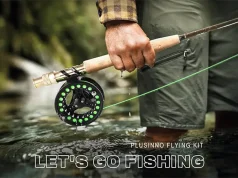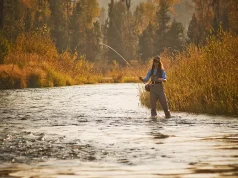Did you know the global recreational fishing market is expected to hit $125 billion by 2025? The rise in fishing’s popularity means having the right gear is crucial for a great time. Whether you’re seasoned or new to fishing, quality rods, reels, and accessories are key to success and fun.
This guide will cover the must-have fishing gear for your next fishing trip. You’ll learn about the different types of rods and their special features. Plus, how to pick the perfect line and reel for your fishing style and the fish you’re after.
Understanding Different Types of Fishing Rods
Exploring the world of fishing rods is key for any angler. It helps improve performance on the water. Knowing the differences between spinning and casting rods can greatly enhance your fishing success.
Spinning Rods vs. Casting Rods
Spinning rods are easy to use and versatile. They’re great for beginners and pros alike. They work well in many fishing situations, from catching small fish to big ones.
Casting rods, on the other hand, are for precise and long-distance casts. They’re perfect for those chasing big trophy fish.
Rod Length and Action Explained
The length of a rod affects its casting distance and control. Longer rods can cast farther and are more powerful. Shorter rods are better for quick, accurate casts.
Rod action, or how much it bends, also matters. It affects the rod’s sensitivity and how well it fights fish.
Material Composition and Durability
The materials used in rods impact their performance and life span. Common materials include carbon fiber, graphite, and fiberglass. Each has its own strengths in weight, strength, and sensitivity.
Anglers need to think about the rod’s material to meet their fishing needs. This ensures the rod is right for their style and preferences.

Must Have Basic Fishing Equipment for Beginners
Starting your fishing journey as a beginner is easy. You only need a few simple and affordable items. A starter fishing kit usually has a rod and reel combo, fishing line, lures or bait, and terminal tackle like hooks and sinkers.
Choosing a versatile spinning rod and reel is a smart start. These are easy to use and work well with many fish and water types. Aim for a 5-6 foot rod with medium-light or medium power, paired with a matching reel. Use a 6-10 lb test monofilament line.
Beginners should also get a basic terminal tackle. This includes different hook sizes, split shot sinkers, and a small tackle box. Don’t forget needle-nose pliers for removing hooks and some soft plastic lures or live bait to attract fish.
With this beginner fishing gear and a starter fishing kit, you’re ready to catch your first fish. The key is to get out there and practice your new skills.
Selecting the Right Fishing Line and Leaders
Choosing the right fishing line and leaders is key for a good fishing trip. Monofilament and braided lines have their own strengths. The right leader material can also make a big difference in your catch.
Monofilament vs. Braided Lines
Monofilament lines are a classic pick, known for their stretch and shock absorption. Braided lines, however, offer more strength, and sensitivity, and are less visible underwater. Many anglers use a braided line with a monofilament or fluorocarbon leader for the best of both worlds.
Leader Materials and Strengths
Leaders are short sections of line at the end of your main line. Fluorocarbon leaders are great for their abrasion resistance and are almost invisible underwater. Nylon monofilament leaders are a budget-friendly option with good durability.
Line Weight Guidelines
Choosing the right line weight is important for your rod and reel setup. Lighter lines, like 4-8 pounds, are good for finesse fishing. Heavier lines, 10-20 pounds, are better for catching bigger fish.
Essential Fishing Reels and Their Features
Choosing the right fishing reel is key for a great day fishing. There are spinning reels, baitcasting, and fly reels, each with its own benefits. Knowing what makes each reel special helps anglers pick the best one for their rod.
Spinning reels are loved by both new and seasoned anglers. They’re great for casting light lures and lines. Features like a smooth drag and balanced spool make them even better.
Baitcasting reels are for those who want more control, especially with heavy lures. Their closed-face design holds more lines and helps manage backlash. Look for gear ratios, brakes, and a strong drag system in a baitcasting reel.
Fly fishing reels are made for managing lines and presentations. Spool size, line capacity, and weight balance are important. These factors greatly affect a fly reel’s performance, making it essential for fly fishing.
Why Choose a Dobyns Rod for Serious Angling
Dobyns rods are top choices for serious anglers. They are known for their excellent craftsmanship and design. Whether you fish for bass or trout, a Dobyns rod will take your fishing to the next level.
Dobyns Rod Series Comparison
Dobyns has a wide range of rods for different fishing needs. You can find the perfect rod for your fishing style and the fish you want to catch. The Sierra series, for example, is great for bass fishing because it’s very sensitive and strong.
Performance Features and Benefits
Dobyns rods are all about performance. They use the best materials, like high-modulus graphite, for strength and sensitivity. Their lightweight design and features like Fuji® components help you feel every bite and make accurate casts.
Tackle Box Organization and Essentials
Organizing your fishing tackle is key for a smooth fishing trip. A well-organized tackle box can greatly improve your success. Start by setting up sections for lures, hooks, sinkers, and more.
Invest in organizers or dividers to keep your tackle in order. This makes it easy to find what you need. Sort your lures by type, size, or color for quick access. Also, have separate areas for terminal tackle like hooks and swivels.
Use foam inserts or trays to protect your lures and prevent tangles. This helps your gear last longer and makes it easier to find. Label each section to keep your tackle box tidy and organized.
Fishing Hooks, Sinkers, and Terminal Tackle
Choosing the right terminal tackle is key to successful fishing. Hooks, sinkers, and other gear are vital for catching more fish and enjoying your time on the water.
Hook Sizes and Applications
Fishing hooks come in many sizes, each for different fish and fishing styles. Small hooks, like size 6 or 8, work well for catching panfish and trout. On the other hand, larger hooks, such as size 2/0 or 4/0, are better for bigger fish like bass or catfish.
It’s important to pick the right hook size and style. This depends on the fish you’re after, the bait or lure you’re using, and the fishing conditions.
Sinker Types for Different Waters
Sinkers help anglers get their bait or lure to the right depth. There are many types, like split shot and egg sinkers for light lines, and pyramid and bank sinkers for surf fishing.
Knowing which sinker to use in different waters is crucial. It can make a big difference in your fishing success.
Weather-Appropriate Fishing Apparel
Anglers need to think about the weather when they go fishing. The right clothes can make a big difference. It can turn a good day into a bad one if you’re not dressed right.
Layering is important for fishing clothes. Start with lightweight, moisture-wicking base layers. They keep you warm and dry. Then, add mid layers like fleece pullovers for extra warmth without getting in the way.
For the top layer, choose a waterproof and breathable jacket. It protects you from wind, rain, and more.
In hot, sunny weather, wear broad-brimmed hats, long-sleeved shirts, and lightweight pants. These help block harmful UV rays. Sunglasses with polarized lenses also help by reducing glare and improving your view on the water.
Waders are essential for fishing in cool or cold weather. They keep your lower body dry and warm. You can choose between chest-high or hip-high waders.
Fish Finder Technology and Navigation Tools
Fishing has changed a lot thanks to new technology. Fish finders, with advanced sonar, are key for serious anglers. They use sound waves to show a detailed map of the underwater world. This helps fishermen find fish and other sea creatures exactly where they are.
Modern Sonar Features
Today’s fish finders have cool sonar features. They have high-resolution screens that show fish and underwater structures clearly. They also have transducers that scan in different ways, giving anglers a lot of information.
With these tools, anglers can see how deep fish are, how big they are, and how they’re moving. This makes it easier to catch the fish they want.
GPS Integration Benefits
Adding GPS to fish finders has changed fishing a lot. It combines sonar data with GPS to show detailed maps of waterways. These maps highlight the best fishing spots and underwater features.
This info helps fishermen find the best places to fish quickly. It saves time and increases the chances of a good catch. GPS has really changed how anglers fish.
Rod Maintenance and Storage Solutions
Keeping your fishing rods in good shape is key for a great fishing trip. Proper care and storage can make your rods last longer. This means they’ll stay in top condition for many years.
Start by cleaning your rods regularly. Use a soft, damp cloth to wipe down the rod blank. This removes dirt, salt, and grime from your adventures. Make sure to clean the guides well to avoid line flow problems.
For a deeper clean, mix mild soap with warm water. Then, dry your rods gently to avoid water damage.
Storing your rods right is just as important. Think about getting a rod rack or case. Rod racks save space and are easy to use. Travel cases protect your rods when you’re moving them around.
When you store rods, be careful with the tip and reel seat. They’re delicate and need to be handled with care.





